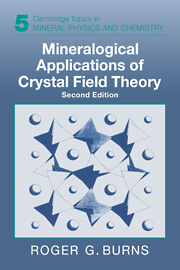Book contents
- Frontmatter
- Contents
- Preface to the first edition
- Preface to the second edition
- 1 Introduction
- 2 Outline of crystal field theory
- 3 Energy level diagrams and crystal field spectra of transition metal ions
- 4 Measurements of absorption spectra of minerals
- 5 Crystal field spectra of transition metal ions in minerals
- 6 Crystal chemistry of transition metal-bearing minerals
- 7 Thermodynamic properties influenced by crystal field energies
- 8 Trace element geochemistry: distribution of transition metals in the Earth's crust
- 9 Mantle geochemistry of the transition elements: optical spectra at elevated temperatures and pressures
- 10 Remote-sensing compositions of planetary surfaces: applications of reflectance spectra
- 11 Covalent bonding of the transition elements
- Appendices
- References
- Subject index
10 - Remote-sensing compositions of planetary surfaces: applications of reflectance spectra
Published online by Cambridge University Press: 23 November 2009
- Frontmatter
- Contents
- Preface to the first edition
- Preface to the second edition
- 1 Introduction
- 2 Outline of crystal field theory
- 3 Energy level diagrams and crystal field spectra of transition metal ions
- 4 Measurements of absorption spectra of minerals
- 5 Crystal field spectra of transition metal ions in minerals
- 6 Crystal chemistry of transition metal-bearing minerals
- 7 Thermodynamic properties influenced by crystal field energies
- 8 Trace element geochemistry: distribution of transition metals in the Earth's crust
- 9 Mantle geochemistry of the transition elements: optical spectra at elevated temperatures and pressures
- 10 Remote-sensing compositions of planetary surfaces: applications of reflectance spectra
- 11 Covalent bonding of the transition elements
- Appendices
- References
- Subject index
Summary
Absorption bands in the visible and near-infrared spectra of Moon and Mars – – correlate well with a narrow choice of minerals. – – they provide a perhaps unique means of remote analysis of some of the abundant mineral phases on the surfaces of the bodies.
J. B. Adams, Science, 159, 1453 (1968)Introduction
Earlier chapters have demonstrated that spectral features of most rock-forming minerals in the visible to near-infrared region originate from the presence of transition elements in their crystal structures. Iron and titanium have higher crustal abundances on terrestrial planets relative to other transition elements and, consequently, are expected to contribute significantly to the reflectance spectra of planetary surfaces. Spectral profiles of sunlight reflected from planetary surfaces, when correlated with measured optical spectra of rock-forming minerals, may be used to detect the presence of individual transition metal ions, to identify constituent minerals, and to determine modal mineralogies of regoliths on terrestrial planets. The origin and applications of such remotesensed reflectance spectra measured through Earth-based telescopes are described in this chapter.
Chemical composition of the terrestrial planets
Properties of the terrestrial planets that are central to this chapter are summarized in table 10.1 and information about element abundances is contained in Appendix 1. The crustal abundance data for the Earth indicate the presence of relatively high concentrations of Fe, and to a lesser extent Ti, compared to other first-series transition elements.
- Type
- Chapter
- Information
- Mineralogical Applications of Crystal Field Theory , pp. 396 - 427Publisher: Cambridge University PressPrint publication year: 1993
- 2
- Cited by



